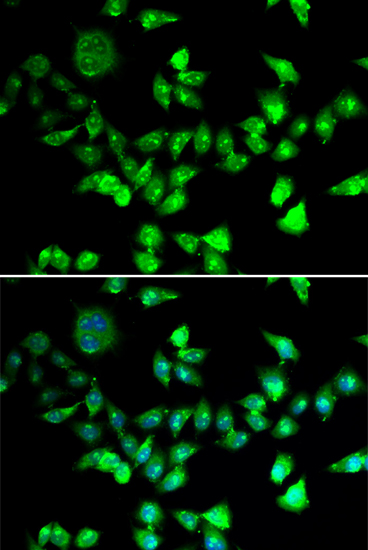| Background: | Proper cohesion of sister chromatids is a prerequisite for the correct segregation of chromosomes during cell division. The cohesin multiprotein complex is required for sister chromatid cohesion. This complex is composed partly of two structural maintenance of chromosomes (SMC) proteins, SMC3 and either SMC1B or the protein encoded by this gene. Most of the cohesin complexes dissociate from the chromosomes before mitosis, although those complexes at the kinetochore remain. Therefore, the encoded protein is thought to be an important part of functional kinetochores. In addition, this protein interacts with BRCA1 and is phosphorylated by ATM, indicating a potential role for this protein in DNA repair. This gene, which belongs to the SMC gene family, is located in an area of the X-chromosome that escapes X inactivation. Mutations in this gene result in Cornelia de Lange syndrome. Alternative splicing results in multiple transcript variants encoding different isoforms. |
| UniProt Protein Function: | Involved in chromosome cohesion during cell cycle and in DNA repair. Central component of cohesin complex. The cohesin complex is required for the cohesion of sister chromatids after DNA replication. The cohesin complex apparently forms a large proteinaceous ring within which sister chromatids can be trapped. At anaphase, the complex is cleaved and dissociates from chromatin, allowing sister chromatids to segregate. The cohesin complex may also play a role in spindle pole assembly during mitosis. Involved in DNA repair via its interaction with BRCA1 and its related phosphorylation by ATM, or via its phosphorylation by ATR. Works as a downstream effector both in the ATM/NBS1 branch and in the ATR/MSH2 branch of S-phase checkpoint. |
| NCBI Summary: | Proper cohesion of sister chromatids is a prerequisite for the correct segregation of chromosomes during cell division. The cohesin multiprotein complex is required for sister chromatid cohesion. This complex is composed partly of two structural maintenance of chromosomes (SMC) proteins, SMC3 and either SMC1B or the protein encoded by this gene. Most of the cohesin complexes dissociate from the chromosomes before mitosis, although those complexes at the kinetochore remain. Therefore, the encoded protein is thought to be an important part of functional kinetochores. In addition, this protein interacts with BRCA1 and is phosphorylated by ATM, indicating a potential role for this protein in DNA repair. This gene, which belongs to the SMC gene family, is located in an area of the X-chromosome that escapes X inactivation. Mutations in this gene result in Cornelia de Lange syndrome. Alternative splicing results in multiple transcript variants encoding different isoforms. [provided by RefSeq, Jul 2013] |
| UniProt Code: | Q14683 |
| NCBI GenInfo Identifier: | 29336622 |
| NCBI Gene ID: | 8243 |
| NCBI Accession: | Q14683.2 |
| UniProt Secondary Accession: | Q14683,O14995, Q16351, Q2M228, |
| UniProt Related Accession: | Q14683 |
| Molecular Weight: | 155 kDa |
| NCBI Full Name: | Structural maintenance of chromosomes protein 1A |
| NCBI Synonym Full Names: | structural maintenance of chromosomes 1A |
| NCBI Official Symbol: | SMC1A |
| NCBI Official Synonym Symbols: | SMC1; SMCB; CDLS2; SB1.8; SMC1L1; DXS423E; SMC1alpha |
| NCBI Protein Information: | structural maintenance of chromosomes protein 1A |
| UniProt Protein Name: | Structural maintenance of chromosomes protein 1A |
| UniProt Synonym Protein Names: | Sb1.8 |
| Protein Family: | Structural maintenance of chromosomes protein |
| UniProt Gene Name: | SMC1A |







